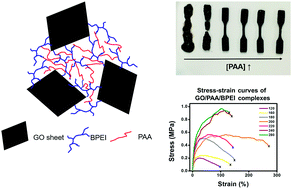Mechanical properties of bulk graphene oxide/poly(acrylic acid)/poly(ethylenimine) ternary polyelectrolyte complex†
Abstract
Ternary complexes formed in a single pot process through the mixing of cationic (branched polyethylenimine, BPEI) and anionic (graphene oxide, GO, and poly(acrylic acid), PAA) aqueous solutions exhibit superior mechanical performance in comparison to their binary analogs. The composition of the ternary complex can be simply tuned through the composition of the anionic solution, which influences the water content and mechanical properties of the complex. Increasing the PAA content in the complex decreases the overall water content due to improved charge compensation with the BPEI, but this change also significantly improves the toughness of the complex. Ternary complexes containing ≤32 wt% PAA were too brittle to generate samples for tensile measurements, while extension in excess of 250% could be reached with 57 wt% PAA. From this work, the influence of GO and PAA on the mechanical properties of GO/PAA/BPEI complexes were elucidated with GO sheets acting to restrain the viscous flow and improve the mechanical strength at low loading (<12.6 wt%) and PAA more efficiently complexes with BPEI than GO to generate a less swollen and stronger network. This combination overcomes the brittle nature of GO–BPEI complexes and viscous creep of PAA–BPEI complexes. Ternary nanocomposite complexes appear to provide an effective route to toughen and strengthen bulk polyelectrolyte complexes.



 Please wait while we load your content...
Please wait while we load your content...
